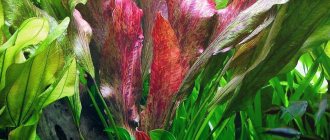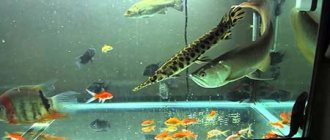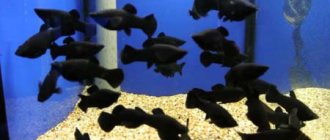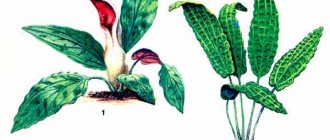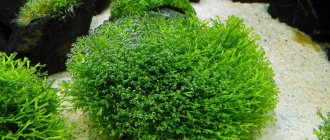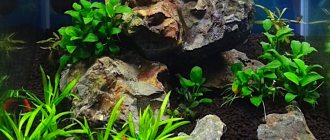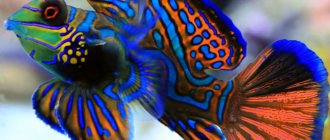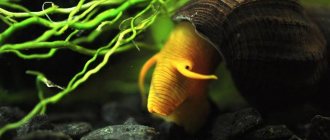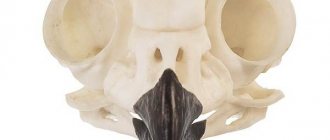Humanity has known about the importance of interaction between flora and fauna for quite some time. Even from school, we know that plants are the most important condition for the existence of the entire animal kingdom - carbon dioxide released during the life of the latter is consumed by plants and processed into oxygen, which is so necessary for respiration. The aquarium environment is no exception - fish simply cannot live long in an aquarium with water devoid of living plants. In addition to producing oxygen, plants in the aquarium promote the development of bacteria, which contribute to more active processing of waste products of organisms, which ultimately has a positive effect on the homeostasis of the entire biotope. Aquarium plants can serve as food for fish; for some species, plant feeding is mandatory. Thickets of aquarium plants provide many species of fish with shelter or a place to play. And a bare aquarium without plants looks quite empty.
What do you need
It is not difficult to provide complete care for plants in an aquarium, excluding rare, demanding species.
To do this you need:
- choose lighting;
- monitor the ground;
- add fertilizer as needed;
- check the condition of the water.
Light is a necessary condition for photosynthesis. Consider the lighting requirements of plants. There are those who love light, and there are those who feel more comfortable in the shadows.
The soil is laid up to 7 cm thick. It must be light so that the rooting process takes place quickly. Industrial fertilizers that can be purchased in stores contain the entire complex of minerals and macroelements necessary for plants. Water most often should be slightly acidic, but before planting a specific species, it is better to double-check the requirements.
Duckweed
Duckweed is a small plant that floats on the surface of the aquarium. The leaves are small, convex at the bottom and filled with air chambers, which ensures the buoyancy of the duckweed. The leaves are solitary, bright, green, oval in shape. Stem up to 2 mm long. Duckweed is a perennial, light-loving plant.
Duckweed can be used as decoration for an aquarium and as an additive to the diet of fish. It is also used to create shadows. Sometimes duckweed gets into the aquarium completely by accident, for example, with other plants or with live food.
Duckweed is unpretentious and gets along well in new conditions. For this plant, it does not matter what quality of water and temperature. It is enough for duckweed if the aquarium temperature is between 12 and 30 degrees. It is a floating plant and requires plenty of overhead light to grow, as well as no strong currents.
Some types of fish (angelfish, goldfish, other viviparous fish) eat duckweed. You can also make dry food from it. The leaves are collected, dried and ground. This food is nutritious and contains many vitamins. Other fish may use duckweed as cover for spawning.
Duckweed reproduces with the help of daughter plants. They are formed along the edges of the leaf plate. The reproduction process occurs very quickly. Let's look at duckweed as a plant that easily takes root in an aquarium, its types with photos and names.
There are several types of duckweed:
- Lesser duckweed - the most common type. The leaves are elliptical in shape, yellowish-green in color. The leaves reach a length of up to 4.5 mm.
- Duckweed multi-rooted - has round leaves up to 6 mm long. The back side of the leaves is purple. This type of duckweed has a bunch of roots coming off each leaf, hence the name.
- Duckweed trilobed - lives in the water column and rises to the surface only during the flowering period. The length of the leaves reaches 1 cm. Duckweed leaves form balls that float in the water. This type of duckweed is rare.
- Duckweed humpback - occurs quite often. The leaves are convex and glossy, 5-7 mm long. This type of duckweed is the fastest growing.
Popular aquarium plants
The following is a brief look at plants that are often planted in aquariums. If you want to know everything about aquarium plants, then for each name or specific name you need to find more detailed information.
Anubias
A plant undemanding to environmental conditions, whose powerful roots grow up to 18–20 cm in length. It has large leaves and is suitable for aggressive fish. Barter's anubias and the dwarf subspecies anubias nana are used in aquariums. Nana grows up to 10–15 cm, prefers shady places in the pond.
Vallisneria
Large grass for the background or corners of the tank. The Vallisneria plant is demanding on environmental conditions, check the water parameters and make a change. There are three types used in aquarium farming: giant, dwarf and spiral. It grows quickly, can grow up to 1.5-2 meters, spreads along the surface of the water. You cannot trim the ends, only thin them out.
Water hyacinth
The second name of the species is Eichornia excellent. A plant with beautiful flowers that smell nice. It grows comfortably in warm conditions (water temperature 25–29 degrees), loves high light levels, even install additional lamps. Perfectly filters water. For hyacinth, it is necessary to leave an air gap of 20 cm above the surface of the water when the aquarium is closed.
Hydrocotyla
White-headed hydrocotyle (lat. hydrocotyle leucocephala) is also called Brazilian stinkhorn. This is one of the most resilient aquarium plants, able to withstand major changes in external conditions. Suitable for beginners. It grows very quickly and spreads along the surface of the water. Small white flowers bloom there too. In bright light they grow faster and vice versa. Regular pruning is required.
Reproduction
Vegetative propagation of plants refers to non-sexual propagation. Below we will describe various breeding methods used in everyday practice, which can be easily used even by novice amateur aquarists.
Cuttings
Most aquarium plants form branched or straight stems. They have nodes from which leaves emerge in different orders, and internodes. Most stem plants in the aquarium are distinguished by the presence of lateral branches emerging from the axils of the leaves. These side branches can be cut off and used as cuttings, so overall propagation is not difficult. Highly branching plants include, for example, Ludwigia and Hygrophila , but also many other plants commonly kept in aquariums.
However, among stem plants there are also plants that rarely develop lateral branches, but whose propagation is very desirable. To stimulate the formation of side shoots, thick stems can be divided into parts, each with 2 - 4 nodes. It is best to divide plants with scissors or a sharp knife below the node where the root later forms. In addition, leaves are removed at this node to avoid rotting in the ground. The top of the mother plant continues to grow unhindered as the main cutting. The remaining part of the cutting is planted in the ground, where after a few days, in most cases, a lateral shoot is formed on the upper node.
Shortening stem-like plants that have become too long in an aquarium is simple: the top is cut off and planted, the rest of the stem can also be divided or left in the ground, where it will begin to branch again.
Species of the genera Hornwort , Egeria , Hydrilla , Lagarosiphon and Naiad grow in natural habitats, in most cases, as if creeping under the water surface, and do not form (or form few) roots with which they take root in the ground . When developing in a flowing stream, plants usually branch more strongly and reproduce by parts of stems, so vegetative propagation of representatives of these genera is also not a problem.
Layerings (offshoots)
Reproduction by layering, which occurs on more or less long creeping shoots of strong mother plants, is of great importance in aquarium farming. Layerings, for example, are formed in Cryptocorynes , small-growing species of Echinodorus , as well as in representatives of the genera Vallisneria and Sagittaria . Also, some floating plants reproduce in a similar way. As an example of particularly productive reproduction, water hyacinth - Eichornia crassipes and Pistia - Pistia stratiotes , as well as the species Trapa natans , Hydrocleys nymphoides and Limnobium laevigatum .
When breeding by layering, aquarists rarely experience complications. But it is worth considering that cuttings should not be separated from the mother plant too early, as they then grow too slowly or stop growing altogether. If the development of Cryptocorynes needs to be interfered with as little as possible, then, say, the species of Echinodorus and Sagittaria require regular thinning of populations that become too dense and recently planted layering. Rhizome division
Many plants form more or less branched and complex rhizomes, which in their natural habitat, as a storage organ, help to overcome unfavorable vegetative periods. For example, the rhizome of Anubias Barter is very long, relatively thin and regularly branching. In contrast, the rhizomes of the mostly branching Echinodorus are strikingly thick, only a few centimeters long, and branching is observed only occasionally in robust mother plants. To increase the rate of reproduction, long rhizomes can be divided with a sharp knife into pieces 2 - 3 cm long, and it is desirable that several buds are preserved on the segments. These pieces in the aquarium can be left on the surface of the water with intense lighting until new plants develop from the spare (dormant) buds.
In Anubias , such propagation by dividing the rhizome is quite productive, but in Echinodorus this does not always lead to a successful result.
Adventive (daughter) plants
Aquarists are well aware of the formation of adventitious plants on the leaves, roots and inflorescences of mother plants. In the ferns Ceratopteris and Microsorum , adventitious buds often form on the edges of the leaves; in the water lily Nymphaea micrantha they can often be observed at the place where the leaf is attached to the stem, so vegetative propagation of these species is not difficult. In Fern Microzorum, rhizomatous processes are also often formed on roots dipped into water.
Broken leaves of Hygrophila and Gymnocoronis spilanthus also form adventitious shoots in the disturbed area, which can be separated when they reach a sufficient size. Some species, for example Samolus vulgaris , Water beetle and Physostegia purpurea form axillary adventitious plants on the flower stem.
of Echinodorus is of great importance for productive reproduction . Depending on the species, they appear in varying numbers on the whorled flower. If flower stems develop on Echinodorus amazonica underwater, it is recommended that, contrary to the desire to come to the surface, they should be submerged under water. Then the formation of the adventitious plant as a whole occurs more intensively than above water, where the daughter plants under the usually low aquarium cover and low humidity quickly dry out and practically do not form rhizomes. Adventitious plants can be separated when they are five centimeters in size and have several roots, and planted in the ground.
Among the Aponogeton family, only Aponogeton wavy ; its buds are formed instead of inflorescences, which appear rarely. Bulbs and tubers
In the culture of ornamental and agricultural plants, propagation using bulbs and tubers is very common. In aquarium plants, tubers are known only in species of the genus Aponogeton , but for the most part they are not capable of forming adventitious tubers.
Bulbs sometimes develop in vigorous plants of the genus Crinum , but this form of propagation is rarely productive. Most often in the aquarium, the formation of bulbs occurs in Crinum calamistratum .
CRYPTOCORYNE: TYPES, DESCRIPTION, BREEDING, CONTENTS, APPEARANCE.
PISTIA: DESCRIPTION, CONTENTS, REPRODUCTION, PHOTO, CARE
RICCHIA: DESCRIPTION, CONTENTS, REPRODUCTION, PHOTO
ELODEA: DESCRIPTION, CONTENTS, REPRODUCTION, PHOTO, CARE.
VALLISNERIA SPIRAL: CONTENTS, TYPES, DESCRIPTION, CULTIVATION
KABOMBA: TYPES, DESCRIPTION, BREEDING, CONTENT
CRYPTOCORYNE: TYPES, DESCRIPTION, BREEDING, CONTENTS, APPEARANCE.
Hornwort - CONTENTS BREEDING DESCRIPTION PHOTO SPECIES.
ECHINODORUS: DESCRIPTION, CONTENTS, REPRODUCTION, PHOTO
JAVA MOSS: CARE, CONTENTS, DESCRIPTION, REPRODUCE, PHOTO
AMBULY - REPRODUCTION CONTENTS DESCRIPTION PHOTO.
Plant care
To properly care for aquarium plants, check the lighting, soil and water parameters. The light requirements of different species differ. For algae, the norm is 1 watt per 1 liter. Others need bright lighting, a certain temperature, acidity. Periodically measure water indicators with indicators. In the soil, use medium-sized sand and gravel for aeration. If necessary, fertilize the plants with fertilizers.
Landing rules
Before planting in the ground, clean each plant from adhering dirt, soak in a solution of potassium permanganate for 15–20 minutes, or rinse with a solution of hydrogen peroxide. Next, rinse with water and plant. When planting in the ground, make sure that the roots are directed downward and do not bend. Plant large, spreading bushes against the back wall. Medium sized plants on the sides or in the center. Covering the bottom and small ones are planted in front. And near the lamps are those who love bright lighting.
How many plants do you need?
Algae, bushes and herbs in the aquarium play an important, but not the main role. Therefore, plant according to your needs. Bushes should not interfere with the movement of active fish; for example, huge bushes will interfere with the movement of chromis. For spawning, when larvae attach to the leaves, plant 2-3 bushes with large leaves.
Advantages
Buying vegetation has several advantages:
- plants are responsible for producing oxygen necessary for all living things;
- plants recreate the natural habitat, so the fish feel more comfortable;
- In the absence of food, the inhabitants of the aquarium can dine on green spaces, which is also a plus. Fish living in an aquarium with algae can (if necessary) be left unattended for several days;
- The condition of the plants can be used to judge the general well-being of the inhabitants of the aquarium. If the plants turn yellow and lose their former attractiveness, it is possible that the fish also live uncomfortable in such conditions;
- fish can hide in thickets of plants; very often aquarium inhabitants spawn in algae;
- The natural beauty of wildlife also plays an important role when choosing decorations for an aquarium.
Diseases
Violation of the living conditions in the aquarium is indicated by the appearance of the plants. Based on this, the following problems are identified:
- slow growth - indicates a lack of carbon;
- blackening of the roots - excessive compaction of the soil, the substrate needs to be replaced;
- flying leaves - lack of phosphorus;
- thin stems, pale leaves - low lighting;
- excessively small leaves - the relationship between temperature and lighting is disrupted;
- leaves turn yellow and red - lack of nitrogen;
- poor appearance of plants - the chemical composition of the water is disturbed, replacement is necessary.
Cryptocoryne
It was brought by aquarists from Southeast Asia, where it lives in the coastal zones of numerous islands, small rivers and ponds with stagnant water. Essentially, these are marsh plants that grow underwater and bloom in the air.
Cryptocoryne , they can be identified solely by the spathe, which consists of a chamber for the inflorescence tube and petal.
Cryptocorynes are very unpretentious. The temperature should be 24-28 °C, the water should be neutral in hardness and acidity. Aquarists recommend changing up to 1/3 of the water in the aquarium weekly for normal growth.
Keep the light not very bright, diffused. We should not forget that the soil must contain nutrient substrates, which consist of complex fertilizers. Also, the soil should be approximately the same temperature as the water, since cool soil will slow down algae growth.
Cryptocorynes do not like replanting, since leaves will appear in a new place only after a few months, even if the care is correct. Cryptocorynes reproduce by shoots that may be located in the substrate. A small leaf formed at the end of the shoot eventually grows into a small bush. After 5-6 leaves are formed on it, and the age is several weeks, Cryptocoryne can be transplanted.
There are a number of species of this plant for the aquarium; below you will see their photos with names:
- Cryptocoryne undulata;
- Cryptocoryne Thwaiteza;
- Cryptocoryne cordate;
- Cryptocoryne spiralis;
- Cryptocoryne related;
- Cryptocoryne purpurea;
- Cryptocoryne ciliata;
- Cryptocoryne pontederifolia;
- Cryptocoryne parva;
- small cryptocoryne;
- Cryptocoryne reverse spiral;
- Cryptocoryne Neville;
- Griffith's Cryptocoryne;
- Beckett's cryptocoryne;
- Cryptocoryne aponoghetonolifolia;
- Cryptocoryne Wendt;
- Cryptocoryne Walker;
- Cryptocoryne Albida.
How to make the right choice
When purchasing algae, inspect the appearance: the presence of dry, damaged fragments, rot. Avoid purchasing aquarium plants that are yellow, reddish, or look sick.
Avoid purchasing from unclear markets from unreliable sellers. Contact specialized stores or experienced aquarists.
After purchasing, allow the algae to acclimate in separate tanks. And only then transplant it into the aquarium.
Summing up
We have described the most unpretentious aquarium plants , but remember that they all require at least minimal care. As a rule, it comes down to choosing the right lighting and comfortable temperature, but some plants are especially demanding about the purity of the water, so a high-quality filtration system and periodic maintenance of the aquarium .
See also : TOP 5 simple ways to fix moss, anubias, bucephalandra in an aquarium. In addition, you will probably be interested in the rarest aquarium fish.
Adviсe
A properly selected plant component of an aquarium makes it possible to solve several problems.
- Water filtration and oxygen enrichment through photosynthesis.
- By selecting the right algae, you can provide the fish in your aquarium with another source of food.
- Lush bushes, grasses and beautiful plant flowers significantly complement the aesthetic appearance of the aquarium.
- Regular replacement of part of the water, timely thinning of plants, the correct ratio of the number of fish, thickets and volume of the aquarium will create adequate conditions for the growth and reproduction of not only fish, but also plants.
Previous
PlantsBright and unpretentious hydrocotyla tripartita
Next
PlantsCommon aquarium ferns: Lomariopsis Lineata, Marsilia, Azolla, Salvinia and others
Decorative purpose
Consider the needs of aquatic inhabitants and the interior of the room. Think about the composition in advance. There are several rules to help create a spectacular pond:
- Place dense and large plants in the background, so they will not block other representatives of flora and fauna.
- Plant medium-sized greens in the middle or along the sides of the tank.
- Place short grass in the foreground.
- For a better view, leave a small distance from the front wall of the aquarium unoccupied.
The background
Unpretentious plants, most suitable for decorating the background:
- Indian and Thai ferns;
- lemongrass;
- hydrocotyla;
- cabomba.
Center
Place in the center:
- a small bush of ferns;
- Echinodorus;
- Vallisneria;
- blue.
Foreground
Place a small and bright flora in front:
- Marsilea hisruta;
- Anubias;
- Cryptocoryne dwarf;
- Staurogyne repens.
Plants of other colors
Dilute the greens with scarlet and purple shades:
- rotals;
- ludwigia;
- bacopa carolina;
- naiads;
- limnophiles.
To ensure rich colors, you will need fertilizer. Sufficient illumination remains the decisive factor.
Name variations
Hygrophila loosestrife is also known as:
- hygrophila elongated;
- hygrophila corymboses;
- Hygrophila corymbosa;
- nomaphyla straight;
- Hygrophila angustifolia.
In everyday speech it is often called lemongrass.
Cladophora
This is an interesting type of aquarium plant that attracts the eye, first of all, with its spherical shape. In addition, cladophora is a natural biofilter that passes aquarium water through itself, naturally filtering it.
It comes in two types:
- The spherical one is the same natural biological filter that we are talking about. Feels good in both soft and hard water. The only thing you need to closely monitor is the water temperature, which should not exceed 25 degrees (for this reason, cladophora is not the best neighbor for tropical fish).
- Filamentous - this variety does not have any decorative value, representing a plant made of hard long threads. This is an undesirable grass for the aquarium, so you can get rid of it by balancing the internal ecosystem.
The spherical cladophora is not demanding on the level of lighting, but you need to ensure that the aquarium water is sufficiently clean.
Sagittaria
The plant is distinguished by bright green leaves that are pointed towards the end. It is not demanding on temperature levels, so it can also be kept in tropical aquariums.
The plant is flowering, but this is only possible if all maintenance rules are followed. Flowering lasts up to 14 days.
Hygrophila
Hygrophila is characterized by rapid growth, as well as unpretentiousness to living conditions. It grows actively throughout the year. It is possible to grow shoots - just plant the cut branch in the ground.
The optimal temperature is from 22 to 27 degrees. There are no special conditions for the lighting level. If the conditions are not ideal, the plant will not die, but will only become less beautiful.
What fertilizers to use
Fertilizers are used for feeding:
- liquid;
- solid.
Liquids are applied directly into the water, and solids are added under the root system into the soil. There are special calculators that allow you to calculate the rate and frequency of product application. Experts advise introducing fertilizers during the day, because energy is needed to absorb nutrients, and it is produced in plants under the influence of light.
